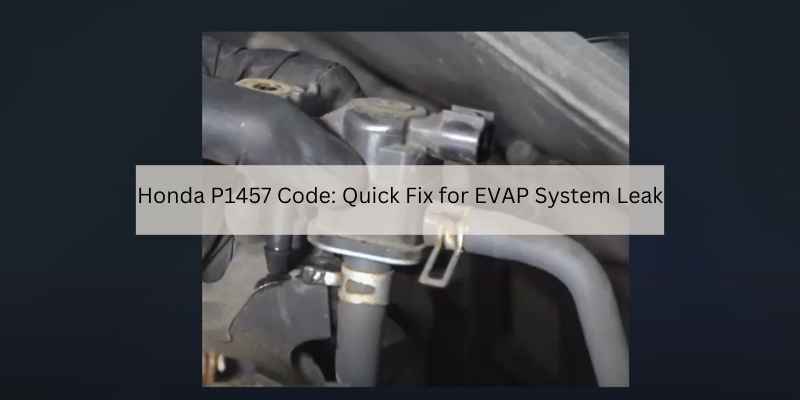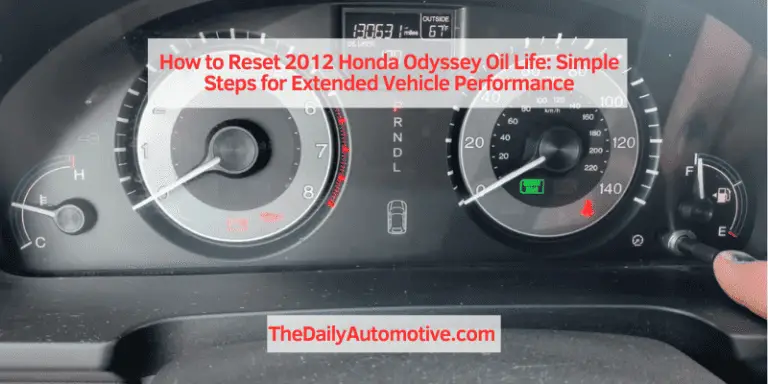Honda P1457 Code: Quick Fix for EVAP System Leak
The Honda P1457 code indicates a problem with the evaporative emission control system, specifically a leak or malfunction in the system. It often relates to the canister or venting valves.
Understanding the Honda P1457 code is crucial for maintaining your vehicle’s performance and emissions standards. This code typically signals issues within the evaporative emissions control system (EVAP). The EVAP system plays a vital role in reducing harmful emissions by capturing fuel vapors from the gas tank and directing them back into the engine for combustion.
A malfunction in this system can lead to increased emissions and potential damage to the engine over time. Drivers should address the P1457 code promptly to ensure optimal vehicle function and compliance with environmental regulations. Regular maintenance and checks can prevent these issues from arising.
Introduction To Honda P1457 Code
The Honda P1457 code indicates a problem with the EVAP system. Drivers may notice several symptoms when this code appears.
Common symptoms of an EVAP system leak include:
- Check Engine Light illuminated
- Decreased fuel efficiency
- Fuel odor near the vehicle
- Difficulty filling the gas tank
Ignoring the P1457 code can lead to serious issues. A leak in the EVAP system may allow harmful fuel vapors to escape. This can increase emissions and affect air quality.
Moreover, neglecting this issue may result in costly repairs down the line. Addressing the P1457 code promptly ensures better vehicle performance and environmental compliance.
Decoding The P1457 Error
The P1457 code indicates a problem within the evaporative emissions control system (EVAP). This code is specific to Honda vehicles and signals a leak in the EVAP system. A common cause is a malfunctioning vent shut valve or a damaged EVAP canister.
Several factors can trigger the P1457 code:
- Damaged or cracked hoses in the EVAP system.
- Faulty gas cap that doesn’t seal properly.
- Defective purge valve affecting pressure.
- Issues with the ECU or electrical connections.
Safety Concerns
Driving with an EVAP leak can be risky. The P1457 code indicates a problem with the evaporative emissions system. This system helps prevent fuel vapors from escaping into the atmosphere. Ignoring this code can lead to serious issues.
Some risks include:
- Increased fuel consumption due to improper fuel vapor management.
- Possible engine performance issues or rough idling.
- Increased emissions, which can harm the environment.
- Potential damage to the catalytic converter, leading to expensive repairs.
Temporary fixes might help, but they are not a long-term solution. It’s best to address the underlying issues as soon as possible.
Inspection And Diagnosis
Start the inspection by checking the fuel cap. Ensure it fits tightly and has no cracks. This is a common source of EVAP codes.
Next, inspect the hoses and lines in the EVAP system. Look for any signs of wear, cracks, or loose connections.
Using a vacuum gauge, test the EVAP system for leaks. A proper seal is crucial for the system’s efficiency.
Check the purge valve and vent valve for functionality. Ensure they open and close as required during operation.
For accurate diagnosis, have a OBD-II scanner ready. This tool helps read trouble codes and monitor system performance.
Lastly, review the vehicle’s manual for specific diagnostic steps relevant to the Honda model.
Common Fixes For P1457 Code
Replacing the EVAP canister is crucial for fixing the P1457 code. This part captures fuel vapors, preventing emissions. A faulty canister can trigger the error code.
Fixing the vent shut valve is another important step. This valve controls vapor flow. If it’s stuck, it can create pressure issues in the system.
Sealing any fuel tank leaks is essential too. Leaks can allow vapors to escape, leading to the P1457 code. Regular checks can help catch these leaks early.
Diy Repair Tips
Replacing the purge control solenoid is straightforward. First, locate the solenoid in the engine compartment. Disconnect the electrical connector and remove the mounting bolts. Pull the solenoid out gently. Make sure to clean the area of any debris.
Install the new solenoid in reverse order. Tighten the bolts securely but do not over-tighten. Reconnect the electrical connector. Finally, check for any leaks before starting the engine.
Sealing minor leaks requires careful attention. First, identify the leak source. Use a clean cloth to wipe the area. Apply a suitable sealant to the leak, ensuring it covers adequately. Allow it to cure as per the manufacturer’s instructions. Test the area again for leaks after curing.
Professional Assistance
Identifying the right moment to seek professional help for your Honda is crucial. A P1457 code indicates an issue with the EVAP system. Symptoms can include poor fuel efficiency and a check engine light. If you notice any unusual noises or smells, it’s time to consult a mechanic.
Choosing the right service is equally important. Look for a certified Honda technician who understands the P1457 code. Check online reviews and ask for recommendations from friends. A trustworthy service center can save you time and money in the long run.
Ensure that the technician uses genuine parts for repairs. This guarantees compatibility and longevity. Regular maintenance can prevent future issues, keeping your Honda in top shape.
Preventive Measures
Regular maintenance of the EVAP system helps prevent issues. Check hoses and connections for any signs of wear or damage. Replace any cracked or loose components promptly. Inspect the fuel cap to ensure it seals properly. A faulty fuel cap can cause leaks.
Keeping the EVAP system clean is essential. Use quality fuel to reduce deposits in the system. Schedule periodic inspections to catch potential problems early. Following the manufacturer’s guidelines for maintenance can extend the life of your vehicle.
| Tip | Description |
|---|---|
| Check Hoses | Look for cracks or wear. |
| Inspect Fuel Cap | Ensure it seals properly. |
| Use Quality Fuel | Reduces deposits in the system. |
| Follow Guidelines | Adhere to maintenance schedules. |
Long-term care includes monitoring for warning lights on the dashboard. Address any alerts immediately to prevent further damage. Regularly clean the EVAP canister to maintain its efficiency. Understanding the system helps in timely repairs.
Frequently Asked Questions
How To Fix Code P1457?
To fix code P1457, inspect the EVAP system for leaks. Check the gas cap, purge valve, and vent valve for proper function. Replace any damaged components. Clear the code and test drive the vehicle to ensure the issue is resolved.
Regular maintenance can prevent future problems.
What Is The P1457 Code For A Honda Accord?
The P1457 code for a Honda Accord indicates an issue with the evaporative emission control system. This typically means there’s a leak or malfunction in the EVAP system. Addressing this code often requires inspecting the gas cap, hoses, and valves for damage or leaks.
Is It Ok To Drive With Evap Leak?
Driving with an EVAP leak is not recommended. It can lead to increased emissions and may affect vehicle performance. If you notice warning lights or issues, have it checked promptly. Temporary fixes may work, but long-term repairs are essential for safe driving.
Always prioritize vehicle health.
What Is The Evap System On A Honda?
The EVAP system on a Honda prevents fuel vapors from escaping into the atmosphere. It captures and stores these vapors in a canister. The system includes valves that control vapor flow to the engine for combustion, helping reduce emissions and improve fuel efficiency.
Conclusion
Understanding the Honda P1457 code is essential for maintaining your vehicle’s performance. Addressing this issue promptly can prevent further complications and costly repairs. Regular diagnostics and proper maintenance will keep your Honda running smoothly. Stay informed and proactive to ensure your car remains in top condition for years to come.







